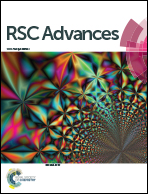Controlled synthesis of 3D hierarchical NiSe microspheres for high-performance supercapacitor design†
Abstract
In this work, hierarchical nanosheet-based NiSe microspheres were successfully fabricated using a facile one-step solvothermal method, in which ethylenediamine and N,N-dimethylformamide were used as the mixed solvent. The evolution of this morphology and the effects of cetyltrimethylammonium bromide were also explored. The as-synthesized NiSe microspheres exhibited the ideal performance when employed as electrode materials of supercapacitors.


 Please wait while we load your content...
Please wait while we load your content...